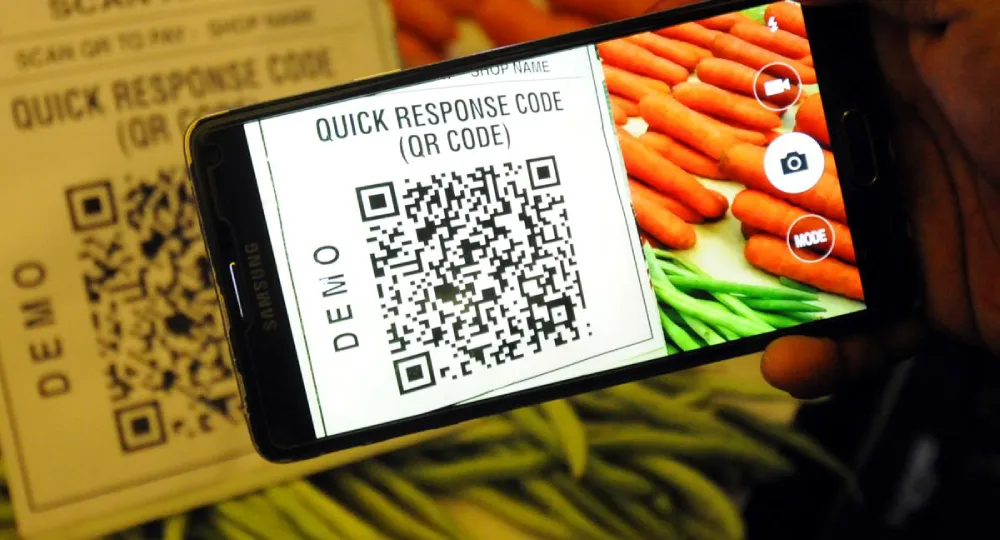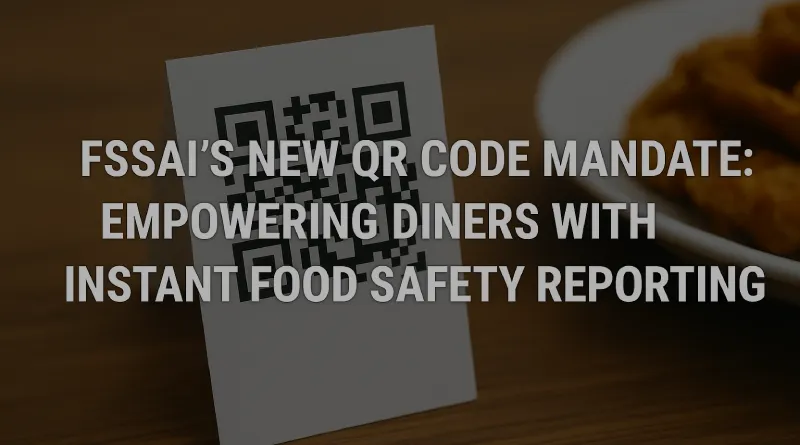FSSAI’s New QR Code Mandate: Empowering Diners with Instant Food Safety Reporting
In a novel step towards improving food safety and consumer empowerment, the Food Safety and Standards Authority of India (FSSAI), through its notice on the mandatory display of QR codes with the Food Safety Connect App by all food business operators (FBOs), including restaurant, cafe, dhaba, and street corner operators, will have to display the QR code on or after August 2025. The July 25, 2025, launched initiative seeks to facilitate grievance redressal, increase transparency, and build confidence in India, whose food industry, covering over 1.4 billion citizens and earning $100 billion a year, is arguably among the most vast in the world, notes Statista. This will help the FSSAI transform the surveillance of food safety, especially in busy markets such as India, where consumers have been dining out every week, 70 percent according to the NRAI figures.
What Is the FSSAI QR Code Mandate?
The FSSAI order mandates every FBO to have their FSSAI license or FSSAI registration certificate displayed prominently and a QR code scanning through which leads the user to the Food Safety Connect App. It is a QR code that has become a compulsory requirement on the licenses and must be present at the route points of the customers, whether at the entrance, the billing counters, or the sitting areas. Identifying the code scanning through their smartphones, the diners will be able to access an application where they can access information on whether the outlet is registered or not, whether they should complain about any hygiene or misleading label, or keep abreast of the latest safety initiatives of FSSAI. Even the online media cannot be ignored, and FBOs will be obligated to integrate the QR code or app download link in their respective websites and food delivery services such as Swiggy and Zomato.
The move is in tandem with the FSS (Licensing and Registration of Food Businesses) Regulations, 2011, and has come amidst increasing concern over food safety breaches, with more than 15 percent of food samples failing in 2024, according to FSSAI sources. The initiative renders such compliance to be visible and actionable, meaning that it enables consumers to hold businesses responsible in real time.
How the Food Safety Connect App Works
The Food Safety Connect App has been crafted to be user-friendly and time-saving, as it is offered both on Android and iOS. Its major characteristics are
- On-the-Spot Reporting: The process allows customers to complain about hygiene, unsafe food, or misleading product claims directly via the app that then automatically directs them to the appropriate jurisdictional authorities, which makes them easily resolved as compared to traditional methods, which may come with delayed responses.
- Verifying Licensure: The QR code scan will indicate whether an outlet is registered or licensed by the FSSAI, a move that will promote transparency because in the same market, 30 percent of restaurants and eateries are said to have been operating without proper certification in 2024 when asked by the FSSAI to audit the industry.
- Safety Alerts: The app gives consumers the latest food safety guidelines and recalls issued by the FSSAI, which is vital information to urban customers in India who regularly have problems with contaminated street food.
- Digital Integration: In the case of online orders, the QR code on delivery programs enables the consumers to check licenses or report complaints without going to the outlet.
This system shifts beyond manual complaint procedures where the diners were forced to visit the managers or attend testing labs, which was in most cases impractical in cities such as Delhi and Mumbai, where people are busy.

Why This Matters for Indian Consumers
The food business in India is enormous, and according to the metrics given by FSSAI, there are more than 2 million FBOs (food business outlets) in the country, including small stalls and gourmet restaurants. Nevertheless, issues related to mislabeling and hygiene violations cannot be ignored, as there are more than 20,000 complaints connected to these reasons made in 2024 only, as India Advocacy estimates. The regulatory requirement on QR codes will counter such challenges by:
- Empowerment of Diners: Street food is part of the culture in cities like Hyderabad; hence, people can now complain about unhygienically prepared street foods instantly, minimizing the health risks. As an illustration, one of the 2023 FSSAI surveys indicated that 25 percent of street vendors in the state of Telangana had no proper sanitation.
- Enhancing Transparency: The fact that licenses and QR codes are displayed visibly keeps FBOs at bay both in cities (major and tier-2) that had varied compliance and Nagpur, which had slow progress, remaining at the bottom of the list.
- Aligned with the Digital India initiative: The app uses digital connectivity to its advantage by engaging more people to take up a shared responsibility of food safety in India since 900 million citizens of the country have smartphone devices (Statista, 2025).
Unique Insights and Local Impact
The requirement is especially relevant to the Indian cuisine world. In rural settings where there is a lack of enlightenment on food safety, the QR code may elucidate the consumer, but the most common factor issues, such as lack of smartphone penetration (30 percent of rural households have smartphones, according to IAMAI), could become the most complex. Cities such as Bangalore, having a strong cafe culture, will experience an accelerated grievance resolution that will improve confidence in restaurants within the area. The reaction on X is split: although @LogicalIndians hailed this action as being a “game changer in terms of consumer empowerment,” there are concerns by users that small merchants may not be able to afford the compliance costs.
The move can also be seen as a reaction to recent FSSAI measures, including investigating deceptive advertising of so-called 100 percent fruit juice products, as well as requiring more vivid nutrition information later in July 2024. In this way, by adopting digital tools, the FSSAI is represented as the lateral line to global trends (e.g., food traceability systems in the EU) and is responding to the national (India-related) issues (e.g., unregulated cloud kitchens that increased 40 percent in 2024, according to RedSeer).
Tips for Consumers and Businesses
For Diners:
- Scan QR codes at eateries to verify licenses and report issues like undercooked food or unhygienic conditions.
- Download the Food Safety Connect App from the Google Play Store or App Store for real-time updates and complaint filing.
- Report persistent issues via the Mi Community app if app-based complaints go unresolved.
For FBOs:
- Ensure QR codes and licenses are displayed prominently to avoid penalties, which can include license suspension under the FSS Act.
- Train staff on hygiene protocols and conduct regular kitchen audits, as advised by food safety experts.
- Integrate QR codes on digital platforms to comply with e-commerce regulations, especially for delivery apps.
Challenges and the Road Ahead
Although the regulation is a step higher toward a healthier food ecosystem, there are issues to overcome. According to The Logical Indian, small traders that make up 60 percent of FBOs in India might experience problems renewing licenses or accessing electronic resources. The app usage might be restricted in remote locations due to connectivity problems, and consumer awareness campaigns will play a central role. The FSSAI intends to hold workshops and use, say, X, to advertise the app on it so that it has 50 million downloads by 2026.
This effort elevates the Indian food safety regime as an example to the other third-world countries in that it manages to strike a point of equilibrium between technology and enforcement of regulations. This is what Rakesh Kumar, the FSSAI regulatory compliance director, has stated: “It is about having every diner demand safe food.” The compliance of QR codes is likely to decrease damages to food safety by a fifth by 2027 by industry standards, thus making eating healthy and open in India.
Disclaimer
The information presented in this blog is derived from publicly available sources for general use, including any cited references. While we strive to mention credible sources whenever possible, Web Techneeq – Web Development Agency in Mumbai does not guarantee the accuracy of the information provided in any way. This article is intended solely for general informational purposes. It should be understood that it does not constitute legal advice and does not aim to serve as such. If any individual(s) make decisions based on the information in this article without verifying the facts, we explicitly reject any liability that may arise as a result. We recommend that readers seek separate guidance regarding any specific information provided here.

